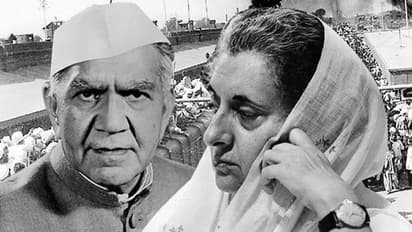Emergency: How Indira Gandhi toyed with democracy to give India its dark days

Synopsis
India was pushed into darkness for 21 months due to the death of democracy, atrocities and excesses of Emergency
New Delhi: At 3:30 pm, on June 25, 1975, Indira Gandhi’s trusted aide Siddhartha Shankar Ray (chief minister of West Bengal) whom she had requested to somehow find a loophole, stormed into her house with a “Eureka” moment.
Ray had spent half of the day thoroughly studying Indian and American Constitutions and finally had found a “loophole”. He explained Indira that the government could impose a state of “Internal Emergency” (External Emergency was already in place from 1971 due to India-Pakistan war) using Article 352 of the Indian Constitution, in the anticipation of internal threat caused by JP movement (Since JP had even called the police & Army to join him, it could be considered a potential “armed rebellion”).
Bingo!! Indira Gandhi’s eyes lit up and her team spent no time in preparing the official document of “Proclamation of Emergency” to be signed by Fakhruddin Ali Ahmed, the President of India. Incidentally, Ahmed was a rubber stamp installed by Indira Gandhi the previous year due to which she was confident that he would return her the favour by unquestioningly approving Emergency. At 5:30 pm, Indira and Ray went to the president's residence and as per their expectations, got it signed without much persuasion.
By the time they returned to Indira’s house, her coterie had already prepared a list of all the Opposition leaders to be put behind bars. Arrest warrants were issued the same night. By 2 am, most of the top Opposition leaders were arrested.
By 3 am, Indira finished drafting her speech and went to bed for a short nap. At 6 am, a Cabinet meeting was held with eight ministers who were dumbstruck with this move when Indira handed them copies of the proclamation of emergency and list of Opposition leaders arrested. The ministers had no choice but to accept the decision by high command.
At 7 am (June 26, 1975), Indira went on air, speaking on All India Radio (AIR) about the decision to impose emergency. She went on to explain about the “Deep and widespread conspiracy” which she claimed was hatched against her to block her from “progressive measures of benefit to common man of India”. She tried to portray the emergency as a “bitter pill” to safeguard the nation from the troubles created by “foreign hand”.
Press was censored. All news articles had to be sent to the government for approval before publishing it the next day. Any form of protest against emergency by newspaper (editors) would be curbed. Most of the newspaper printers had come to a standstill because the government had cut off their electricity supplies to make them “fall in line”. While several news editors used different strategies to voice out their protest, Indian Express protested by leaving the editorial section blank!
Censorship of the press had led to regular large-scale rumours going viral. Indira tried to counter them using dictatorial methods like installing large billboards “ordering” people to avoid loose talks and do their “duties”.
Apart from such billboards, there were government sponsored videos which were aired on TV and advertised in theatres to pursue people to avoid rumours.
All forms of protests (dharnas, gheraos, satyagrahas etc) were curbed using “Maintenance of Internal Security Act (MISA)”. Even the common man was not spared and just a trivial criticism of Emergency or Indira or the government was sufficient to invite arrest. There were several instances where the MISA Act was misused for personal and political vendetta as well. Due to the number of arrests outnumbering the capacity of jails, many were just tied with chains to poles and pillars.
A powerful documentary titled “Zameer Ke Bandi (Prisoners of Conscience)” produced in 1978 (with several interviews with victims) by an eminent filmmaker shows how several innocent men and women (who had no political links) were jailed for trivial reasons. For example, the very first interview of the documentary is about a young man who was jailed and tortured for drawing a sketch of Indira behind bars.
Even royalty was not spared. Rajmata Vijayaraje Scindia and Maharani Gayatri Devi were also arrested.
Organisations like RSS were banned and most of its prominent leaders were arrested. However, some of the leaders went “underground” to carry out back-end activities like spreading real news to people (since newspapers were censored), creating awareness and acting as messengers of those leaders who were imprisoned.
For example, 25-year-old Narendra Modi and Indira’s most outspoken critic Dr Subramanian Swamy disguised themselves as Sikhs during the Emergency period to avoid being arrested and acted as messengers.
India was pushed into darkness for the next 21 months due to the death of democracy, atrocities and excesses of Emergency. Indira’s son Sanjay Gandhi unleashed a slew of projects which eventually backfired due to his political immaturity. The mother-son duo had held the nation hostage.
Stay updated with the Breaking News Today and Latest News from across India and around the world. Get real-time updates, in-depth analysis, and comprehensive coverage of India News, World News, Indian Defence News, Kerala News, and Karnataka News. From politics to current affairs, follow every major story as it unfolds. Get real-time updates from IMD on major cities weather forecasts, including Rain alerts, Cyclone warnings, and temperature trends. Download the Asianet News Official App from the Android Play Store and iPhone App Store for accurate and timely news updates anytime, anywhere.